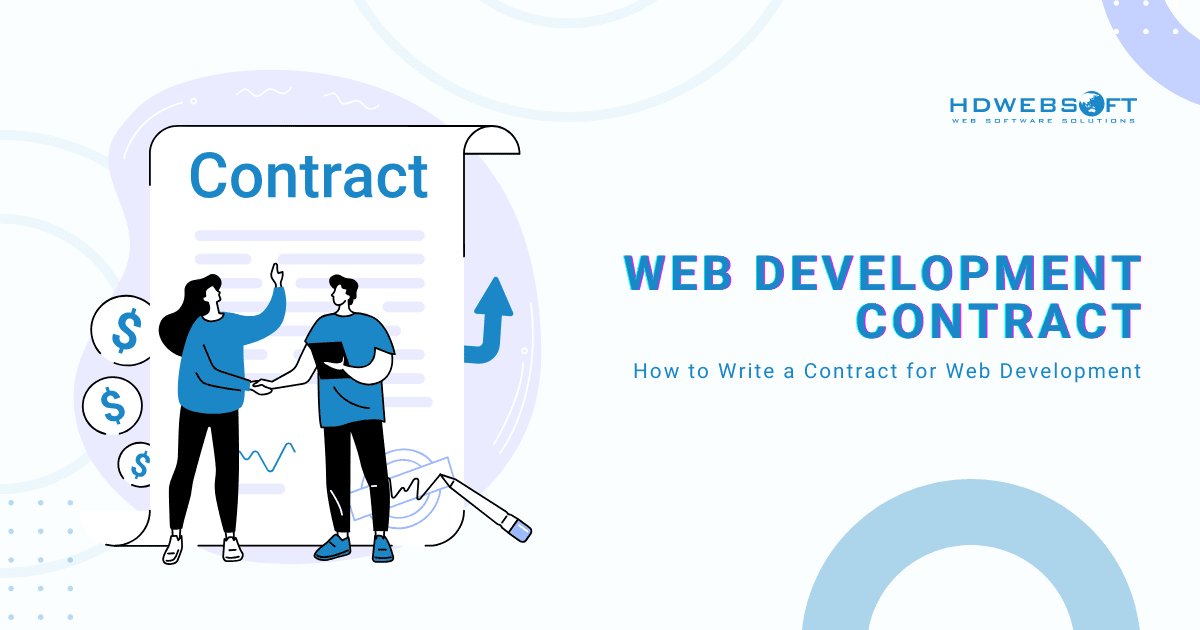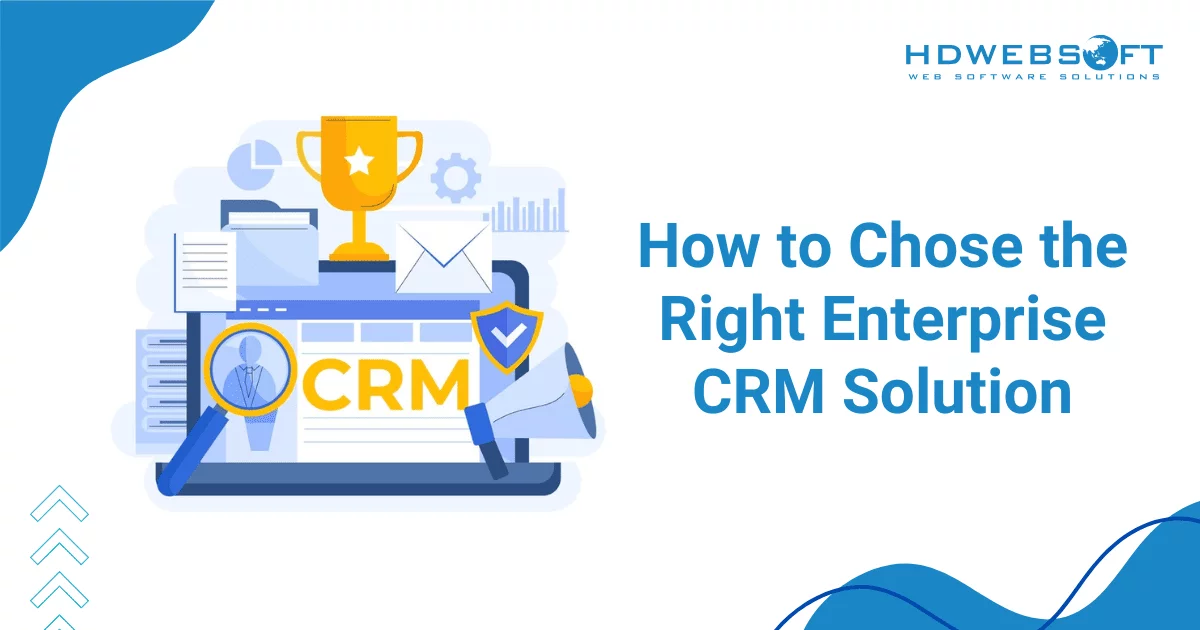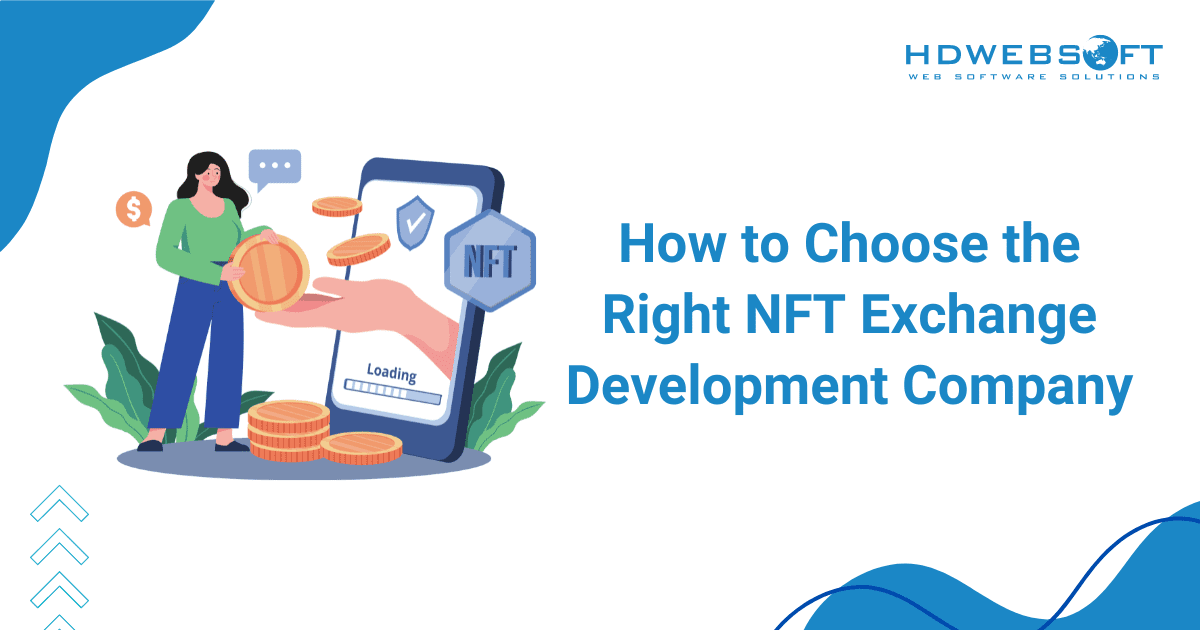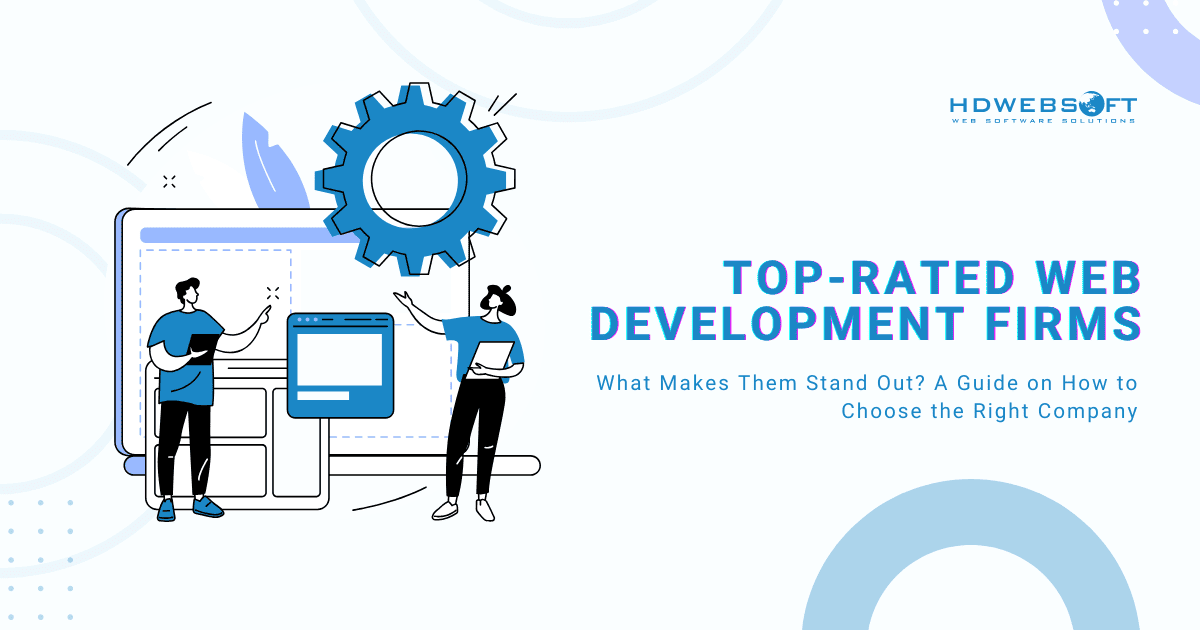
What Makes Top-Rated Web Development Firms Stand Out? Your Complete Guide
Top-rated web development firms are transforming how businesses establish their digital presence. And yet, finding the right partner among thousands of options can feel overwhelming. Whether you’re a startup launching your first platform or an enterprise scaling your digital infrastructure, the development company you choose will significantly impact your project’s success, timeline, and long-term ROI.
In this guide, you’ll first discover how to evaluate development companies using proven criteria. Next, you’ll explore pricing models that suit different budgets. And afterward, you’ll learn the key questions to ask before signing a contract. By the end, you’ll have a clear roadmap for identifying web development solutions that align with your conditions.
- 1) What Defines a Top Web Development Firm?
- 2) Top-Rated Web Development Firms By Category
- 3) Understanding Web Development Pricing Models
- 4) How to Choose Among Top Web Development Firms for Your Project Needs
- 5) Essential Resources and Tools for Web Development Projects
- 6) Red Flags and Common Mistakes to Avoid
- 7) Conclusion
What Defines a Top Web Development Firm?
Distinguishing truly exceptional development companies from average ones requires looking beyond flashy websites and marketing promises. Several critical factors separate industry leaders from the rest.
Key Evaluation Criteria
Engineering proficiency
Technical expertise forms the foundation of all top-rated web development firms. Reputable firms maintain proficiency across multiple programming languages, frameworks, and platforms, from React and Vue.js to Node.js and Python. Moreover, they stay current with emerging technologies like AI integration, blockchain applications, and serverless architectures.
Portfolio quality offers tangible proof of a company’s capabilities. Rather than simply counting projects, examine the complexity, innovation, and business impact of their previous work. You should look for detailed case studies that demonstrate problem-solving abilities, not just aesthetic designs in their web development solutions.
Communication and Support Standards
Client reviews and testimonials provide invaluable insights into the actual working experience. However, don’t just focus on star ratings. Please review the detailed feedback regarding communication responsiveness, deadline adherence, and the quality of post-launch support. Platforms like Clutch, GoodFirms, and G2 aggregate verified reviews from real clients.
Moreover, the project management approach has a significant impact on your day-to-day experience. top-rated web development firms utilize proven software development methodologies like Agile or Scrum, provide transparent progress tracking, and maintain regular communication cadences.
Post-launch support distinguishes companies committed to long-term success from those focused solely on project delivery. Quality firms offer maintenance packages, security updates, performance monitoring, and scalability planning as part of their service ecosystem.
Security and Compliance
Industry-specific experience matters when your project involves specialized requirements. For instance, healthcare applications require HIPAA compliance knowledge. Meanwhile, financial platforms necessitate stringent security protocols and a deep understanding of regulations.
Security and compliance standards have become non-negotiable in today’s digital environment. Premier development companies implement security best practices from project inception, conduct regular vulnerability assessments, and maintain compliance with relevant regulations.
Here is a summary of key factors that define top-tier development companies:
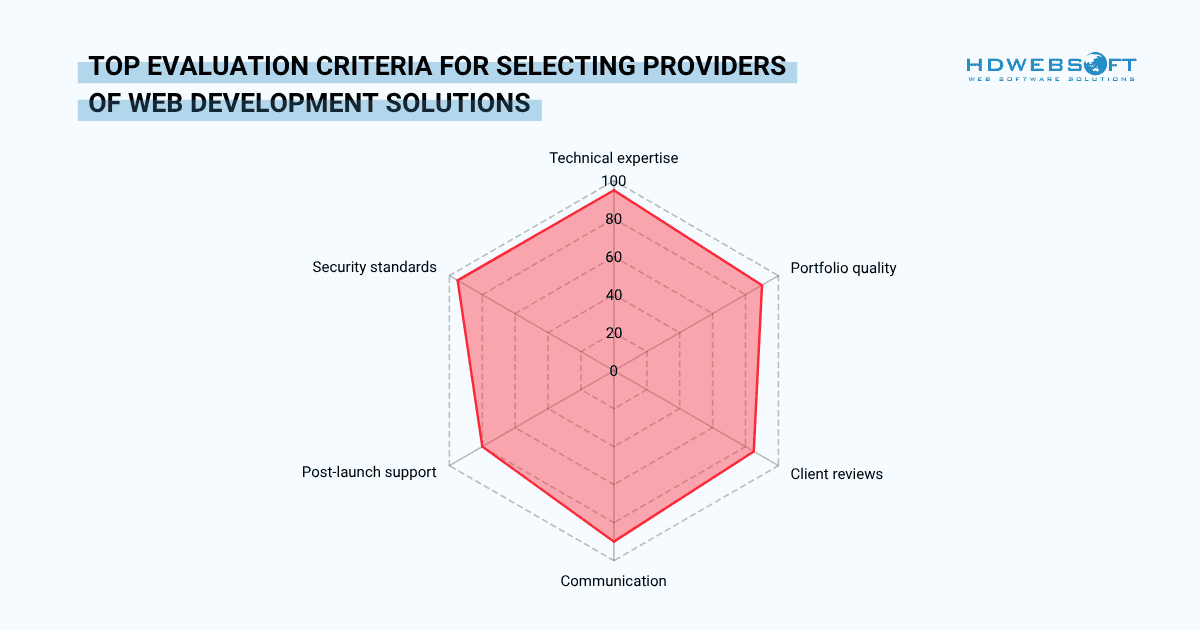
Company Size Considerations
Understanding the trade-offs between different company sizes helps you select the right fit for your specific needs.
- Enterprise agencies typically employ 200+ developers and handle complex, multi-million dollar projects. top-rated web development firms offer comprehensive service suites, established processes, and resources to manage large-scale deployments. These firms excel when you need extensive resources, proven scalability, or enterprise-grade support structures.
- Boutique firms usually consist of 10-50 professionals who provide personalized attention and flexible approaches. They often specialize in specific industries or technologies, delivering deep expertise in their focus areas. This option works well for mid-sized businesses seeking customized web development solutions without enterprise-level budgets.
- Freelancers provide the most cost-effective option for straightforward projects with clearly defined scopes. Consider this route for MVP development, minor enhancements, or projects under $15,000.
Geographic Considerations
Location significantly impacts cost, communication, and cultural alignment.
- Local development companies facilitate in-person meetings, operate in your time zone, and understand regional market nuances. Though they are typically at premium rates.
- Remote domestic companies offer similar cultural and language alignment with more competitive pricing.
- Offshore top-rated web development firms provide substantial cost savings but may present communication challenges and time zone differences.
Top-Rated Web Development Firms By Category
Navigating the development company landscape becomes easier when you understand how firms specialize across different market segments and service offerings.
Enterprise-Level Top Web Development Firms
Large-scale organizations requiring robust, scalable web development solutions benefit most from enterprise-level providers with proven track records handling complex deployments.
Thoughtbot
Stands as a product design and development consultancy specializing in Ruby on Rails and React applications. Their portfolio includes partnerships with major brands, with particular strength in building MVPs that scale. Notable clients include T-Mobile and Politico. Projects typically start around $200,000.
EPAM Systems
Operates as a global engineering powerhouse serving Fortune 1000 companies across industries. With over 50,000 engineers worldwide, they excel at enterprise digital transformation, cloud migration, and custom software development. Engagement minimums typically start at around $500,000 for major enterprise initiatives.
Intellectsoft
Delivers end-to-end digital transformation services with particular expertise in emerging technologies like blockchain, IoT, and AI integration. As one of the top-rated web development firms, they’ve worked with companies like Universal Pictures and Eurostar. Enterprise projects typically range from $250,000 to multi-million dollar engagements.
Netguru
Combines product design with development expertise, focusing on web and mobile applications for scale-ups and enterprises. Their process emphasizes rapid prototyping and iterative development, with strong capabilities in React, Node.js, and Ruby on Rails. Projects generally start around $100,000.
Mid-Market Web Development Agencies
Growing businesses seeking quality web development solutions without enterprise-level budgets may find ideal partners in mid-market agencies.
HDWEBSOFT
Delivers comprehensive website development services with a focus on custom web and mobile applications, e-commerce platforms, and digital transformation projects. Our team specializes in modern frameworks, including React, Angular, and Vue.js, combined with robust backend solutions.
As one of the top-rated web development firms, we’ve built a reputation for delivering scalable solutions that grow with businesses. Our clients span across North America, Europe, and the Asia-Pacific region, with different industry backgrounds. Our project engagements typically range from $50,000 to $300,000.
Codal
Operates as a UX-focused development agency serving mid-market and enterprise clients with complex web and mobile needs. They emphasize human-centered design combined with technical excellence across React, Node.js, and cloud platforms. Their client roster includes United Airlines and Motorola. Projects generally range from $75,000 to $400,000.
Emerge Interactive
Specializes in Drupal and WordPress enterprise implementations alongside custom application development. They’ve built a strong reputation in higher education and association sectors. Typical engagements fall between $60,000 and $250,000.
Specialized Development Companies
Certain projects demand niche expertise that specialized firms deliver more effectively than generalist agencies.
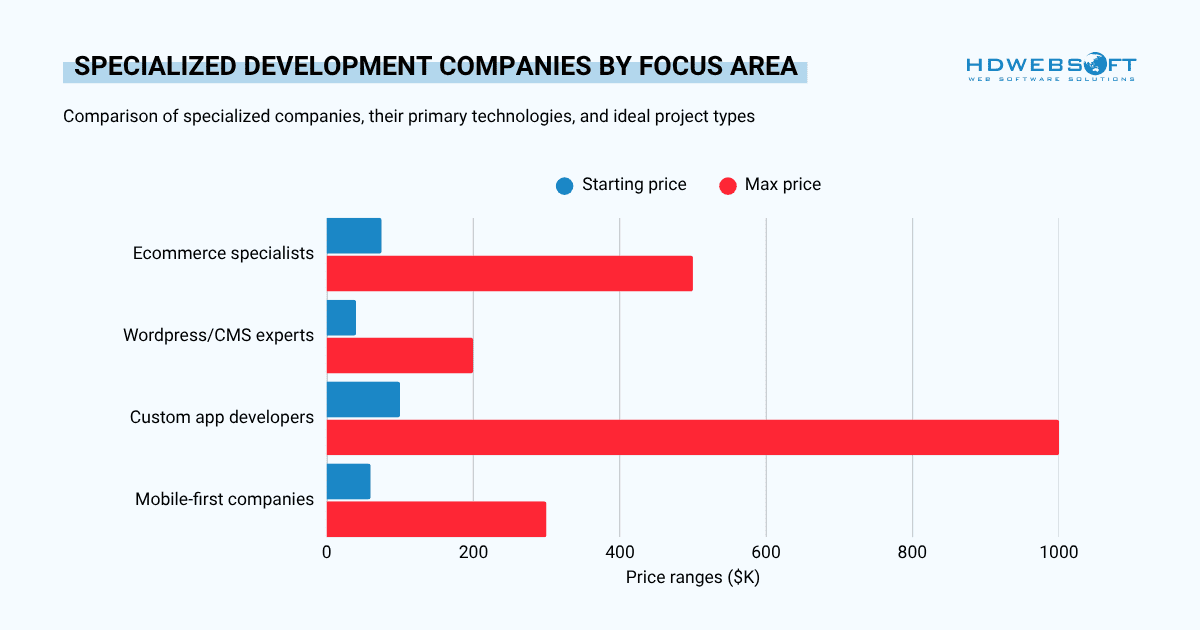
E-commerce and CMS Specialists
- E-commerce specialists like Blue Acorn iCi focus exclusively on platforms like Shopify Plus, Magento, and custom headless commerce solutions. These top-rated web development firms understand complex product catalogs, payment gateway integrations, and conversion optimization strategies. Projects range from $75,000 for Shopify Plus implementations to $500,000+ for enterprise headless commerce architectures.
- WordPress/CMS experts such as 10up and WebDevStudios deliver enterprise-grade WordPress implementations with custom theme development and headless CMS architectures. They’re ideal for content-heavy sites requiring editorial workflows and multi-site management. Engagements typically span $40,000 to $200,000.
Custom and Mobile-First Development
- Bespoke application developers like Railsware concentrate on building custom web development solutions from scratch using modern frameworks. They excel when off-the-shelf platforms can’t meet unique business requirements. Budget expectations start around $100,000 and can exceed $1 million for sophisticated platforms.
- Mobile-first development companies, including Fueled, prioritize responsive, mobile-optimized experiences using progressive web app (PWA) technologies. Projects generally range from $60,000 to $300,000.
Emerging and Innovative Companies
Forward-thinking businesses seeking cutting-edge web development solutions should consider top-rated web development firms leading in next-generation technologies.
- Builder.ai leverages AI-assisted development to accelerate the building of custom applications while reducing costs. Their platform combines human expertise with machine learning to streamline repetitive development tasks. Pricing starts around $30,000.
- Vercel (creators of Next.js) offers development services alongside their hosting platform, specializing in edge computing, serverless architectures, and performance-optimized React applications. Project costs typically start around $75,000.
- Prismatic focuses on integration-first development, building platforms designed for extensive third-party connectivity. These specialized projects generally begin around $100,000.
Companies in this category often incorporate AI features. They excel in implementing progressive web app capabilities and pioneer new frameworks before they achieve mainstream adoption.
Understanding Web Development Pricing Models
Financial considerations significantly influence your choice among top-rated web development firms. However, pricing structures vary substantially based on the project approach and engagement type.
Pricing Models
Fixed-Price Projects
Firstly, fixed-price contracts establish a predetermined total cost for delivering specified features and functionality. This model provides maximum budget certainty, making it easier to secure internal approvals and manage cash flow. Additionally, it transfers risk to the development company, motivating them to work efficiently.
Nonetheless, this approach requires extremely detailed specifications up front. Any scope changes typically trigger change orders with premium pricing, reducing flexibility as your project evolves. Hence, fixed-price agreements work best for well-defined projects like website redesigns, platform migrations, or implementing established feature sets.
Time and Materials (Hourly/Monthly)
Secondly, this kind of contract bills for actual hours worked or monthly retainers for dedicated teams. This flexible approach accommodates evolving requirements, allows iterative development based on user feedback, and aligns well with Agile methodologies.
Under this model, you pay only for work performed, though total costs remain uncertain until project completion. Most top-rated web development firms prefer this approach for complex projects where requirements will inevitably evolve. This structure excels for complex custom applications, long-term product development requiring iteration, and projects exploring new technologies.
Hourly rates vary dramatically by company location and expertise level:
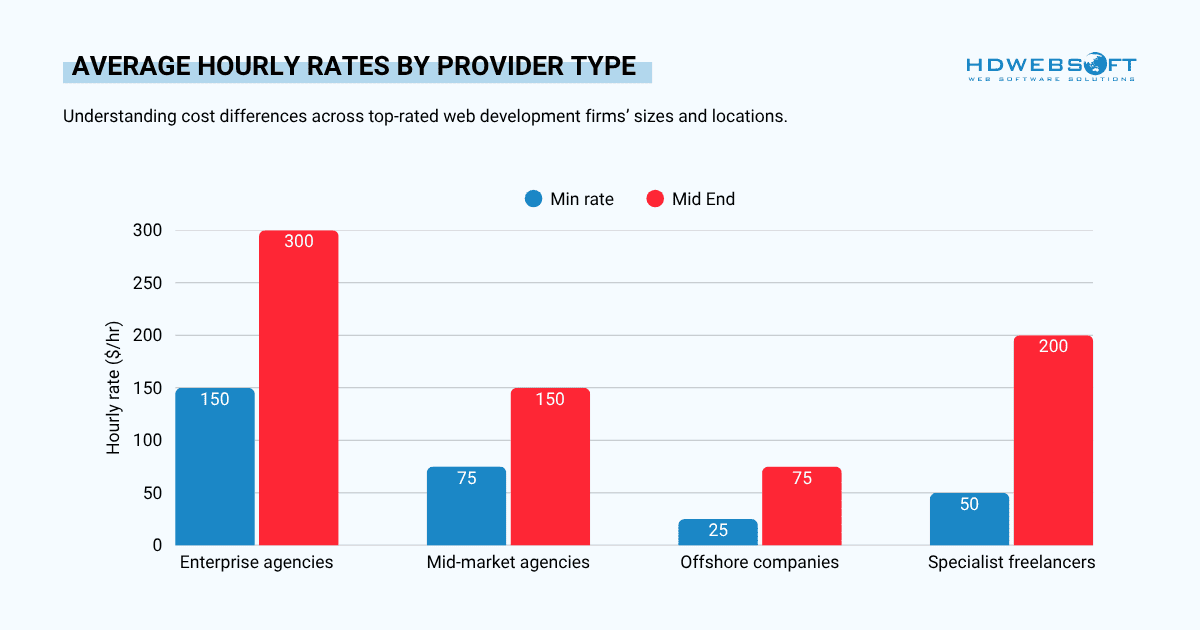
Retainer Agreements
Lastly, retainer arrangements provide dedicated development capacity for ongoing work, combining predictable monthly costs with maintained flexibility. Companies purchase a set number of hours monthly, often at discounted rates compared to ad-hoc billing.
This model suits businesses requiring continuous enhancement, regular maintenance, or responsive support for production issues. Retainers typically offer 10-20% savings versus standard hourly rates while guaranteeing resource availability.
Factors Affecting Development Costs
Beyond pricing models, numerous variables influence your investment in web development solutions.
- Project complexity represents the most significant cost driver. Simple brochure sites require minimal backend logic. Meanwhile, complex applications demand custom architectures, advanced features, extensive testing, and sophisticated security measures.
- Technology stack choices impact both initial development and long-term maintenance costs when partnering with top-rated web development firms. Established frameworks like WordPress or Shopify reduce upfront expenses but may limit customization. In addition, cutting-edge technologies require specialized expertise commanding premium rates.
- Timeline requirements directly affect resource allocation and costs. Rushed projects require additional developers working in parallel, overtime hours, and expedited testing cycles. They all increase expenses by 30-50% or more.
- Company location and size create substantial pricing variations. Enterprise agencies in major US cities charge premium rates. Concurrently, mid-sized firms in secondary markets or nearshore locations offer excellent value.
Typical Cost Ranges by Project Type
Therefore, understanding market rates helps you budget appropriately and identify proposals that seem unrealistic.
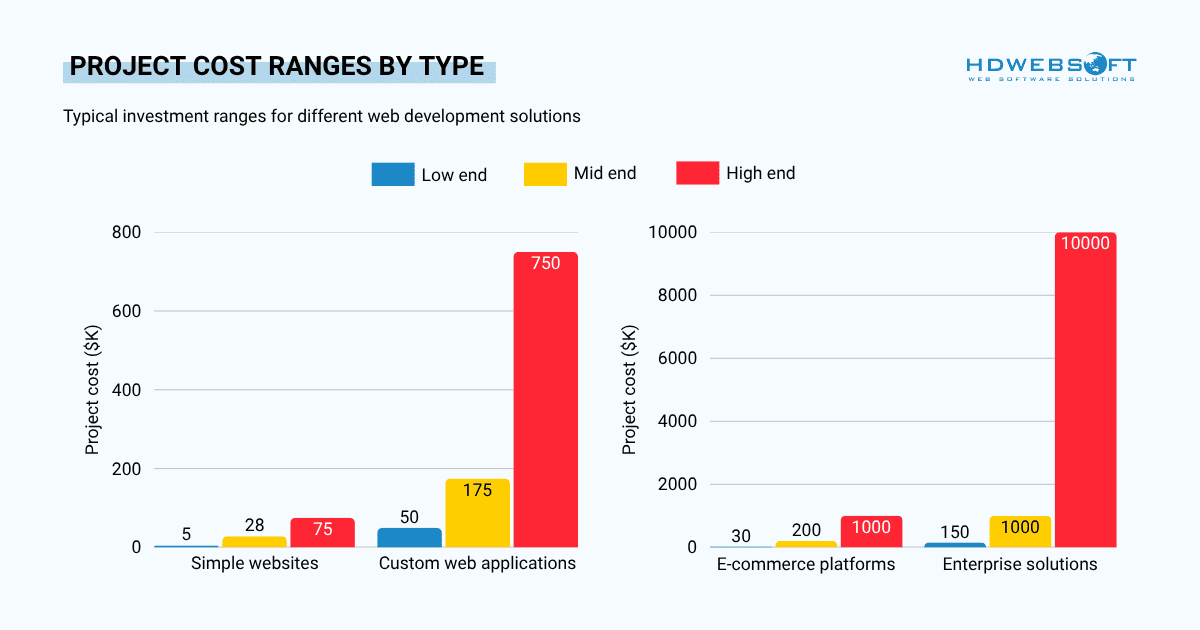
Simple websites (5-20 pages, content management, contact forms):
- Template-based: $5,000-$15,000
- Custom design: $15,000-$40,000
- Premium agency: $40,000-$75,000
Custom web applications (user authentication, databases, admin panels):
- Basic functionality: $50,000-$100,000
- Moderate complexity: $100,000-$250,000
- Enterprise-grade: $250,000-$750,000
E-commerce platforms (product catalogs, payment processing, inventory):
- Shopify/WooCommerce customization: $30,000-$80,000
- Custom platform on Magento/Shopify Plus: $100,000-$300,000
- Headless commerce solution: $250,000-$1,000,000+
Enterprise solutions (multi-tenant architecture, complex integrations):
- Departmental tools: $150,000-$500,000
- Company-wide platforms: $500,000-$2,000,000
- Industry-specific solutions: $2,000,000-$10,000,000+
These ranges represent the total project costs associated with partnering with top-rated web development firms, encompassing design, development, testing, deployment, and initial support. Ongoing maintenance typically adds 15-25% of initial development costs annually.
How to Choose Among Top Web Development Firms for Your Project Needs
Selecting from among numerous web development solutions requires a systematic approach that balances technical capabilities with business alignment.
Step 1: Define Your Project Requirements
Clarity about your goals, constraints, and success criteria forms the foundation for effective vendor selection. Begin by documenting the core features and functionality your website must deliver. Additionally, distinguish between “must-have” requirements that define the minimum viable product and “nice-to-have” features that can be phased in later.
Furthermore, timeline and budget constraints should be realistic yet firm. Research typical development costs for your project category, then add 20-30% contingency for unforeseen complexities.
Another noteworthy point is that long-term maintenance needs often get overlooked during initial planning. Consider whether you’ll handle updates in-house, need ongoing development partnerships, require 24/7 support availability, or plan major enhancements within 12-24 months.
Step 2: Research and Shortlist Candidates
Finding reputable top-rated web development firms requires looking beyond search engine results and marketing materials.
Where to Find Top-Rated Web Development Firms
Start with specialized directories like Clutch, GoodFirms, or The Manifest, which verify client reviews and project details for web development solutions. Industry associations maintain member directories with credentialing requirements. Professional networks often yield the most reliable recommendations. You can ask colleagues, attend industry events, or post in relevant online communities.
What’s more, LinkedIn searches reveal companies’ team sizes and client testimonials. Simultaneously, GitHub profiles demonstrate code quality and active development practices for technical evaluation.
Red Flags to Watch For
Warning signs include:
- Vague portfolios without detailed case studies
- Absence of verifiable client reviews on independent platforms
- Reluctance to provide references
- Significantly lower pricing than market rates
- Aggressive sales tactics or pressure to commit quickly
You should watch for additional red flags during conversations, such as difficulty in explaining their development process clearly. Likewise, an inability to discuss specific technologies is another warning sign.
Even top-rated web development firms that focus only on design while avoiding technical implementation questions should be approached with care. And above all, unrealistic promises about timelines are a serious concern.
Step 3: Evaluate Top-Rated Web Development Firms’ Proposals and Portfolios
Proposal quality often reflects the execution quality you’ll experience during development.
What to Look for in Case Studies
Effective case studies should cover:
- Explain the client’s business challenge
- Describe the strategic approach and technical solution
- Detail measurable results or business impact
- Discuss obstacles encountered and how they were overcome
The best advice we can offer is to be cautious of portfolios that showcase only visual designs without discussing the underlying technical complexity. Make a mental note to examine whether the featured projects align with your complexity level and industry. Companies that primarily build brochure sites may struggle with complex applications.
Understanding Technical Proposals
Quality proposals from top-rated web development firms demonstrate comprehension of your requirements through these factors:
- Detailed feature documentation
- Explain recommended technology choices with clear reasoning
- Outline development phases with specific deliverables
- Testing and quality assurance processes
Budget breakdowns should itemize costs by feature or phase rather than providing single lump sums. Meanwhile, transparency about what’s included versus out-of-scope helps avoid surprise charges later.
Step 4: Check References and Reviews
Third-party validation provides crucial insights into actual working relationships beyond marketing promises. Look for review patterns rather than isolated experiences. Multiple complaints about similar issues (communication gaps, missed deadlines, quality concerns) obviously indicate systemic problems.
Key questions for references
When speaking with former clients, you should ask the following questions:
- Did the company deliver on time and within budget?
- How did they handle unexpected challenges?
- Would you hire them again?
- What was communication like throughout the project?
- What was the transition like from launch to ongoing support?
Step 5: Assess Cultural Fit and Communication
The technical capabilities of top-rated web development firms alone don’t guarantee successful partnerships. Working relationships matter equally.
- Communication styles should align with your preferences. Discuss expectations upfront regarding preferred communication channels, meeting frequency and format, response time expectations, and availability during your business hours.
- Cultural compatibility extends beyond communication to working philosophies. Consider whether the company embraces Agile iteration or prefers detailed upfront planning, values client collaboration, or prefers working independently. In addition, they should be able to demonstrate flexibility in adapting to your processes.
- During initial conversations, evaluate how well the company listens versus how they talk. Asks them thoughtful questions about your business context, admits knowledge gaps honestly, and explains technical concepts in accessible language.
Essential Resources and Tools for Web Development Projects
Understanding what providers leverage throughout their development process helps you evaluate their sophistication and know what to expect during collaboration.
Project Management Platforms
Reputable and top-rated web development firms utilize robust project management systems that provide transparency and facilitate collaboration.
- Jira dominates enterprise development environments with comprehensive issue tracking, Agile sprint management, and customizable workflows. It’s particularly strong for complex projects requiring detailed requirement tracking and bug management.
- Asana offers more accessible project management with user-friendly interfaces and flexible views. It works well for projects where client stakeholders need regular visibility without technical jargon.
- Monday.com provides highly customizable workflows with visual dashboards and automated notifications. Its flexibility adapts to various project management methodologies without imposing rigid structures.
Companies should provide you with access to their project management platform. Alternatively, they should regularly export reports that display progress, outstanding issues, and upcoming milestones.
Communication Tools for Client-Developer Collaboration
An effective communication infrastructure prevents misunderstandings and keeps everyone aligned throughout development.
- Slack or Microsoft Teams serves as primary communication hubs for most development projects. These platforms enable top web development companies to have real-time messaging, threaded conversations by topic, file sharing, and integration with other development tools.
- Zoom or Google Meet facilitates video conferencing for sprint planning, demos, and complex discussions better suited to face-to-face interaction.
- Loom enables asynchronous video updates where team members record screencasts explaining features or demonstrating bugs. This tool is particularly valuable across time zones.
Design and Prototyping Resources
Modern web development solutions begin with thoughtful design processes that validate concepts before expensive development begins.
- Figma has become the industry standard for collaborative web design, offering real-time collaboration, comprehensive component libraries, interactive prototyping, and developer handoff tools. Stakeholders can comment directly on designs, streamlining feedback cycles.
- Adobe XD provides similar capabilities within Adobe’s ecosystem, preferred by design teams already using Photoshop and Illustrator.
- InVision specializes in prototyping and stakeholder feedback, allowing interactive demonstrations of proposed designs before developers write code.
Top-rated web development firms should share design files and prototypes early for your feedback. Catching design issues during prototyping costs far less than rebuilding completed features.
Testing and Quality Assurance Tools
Rigorous testing separates professional web development solutions from amateur implementations prone to bugs and poor user experiences.
- Automated testing frameworks like Jest, Cypress, and Selenium enable developers to create test suites that verify functionality automatically. Ask potential development partners about their testing coverage. For your information, quality companies aim for 70-90% test coverage on critical features.
- BrowserStack and Sauce Labs provide cross-browser testing across numerous devices and browser combinations. They will make sure consistent experiences whether users access your platform on iPhone Safari, Windows Chrome, or Android Firefox.
- Performance testing tools such as Lighthouse, WebPageTest, and GTmetrix measure load times, identify performance bottlenecks, and recommend optimizations. Page speed directly impacts user engagement, conversion rates, and search rankings.
Analytics and Performance Monitoring
Top-rated web development firms emphasize that post-launch success depends on ongoing measurement and optimization of real user behavior and system performance.
- Google Analytics remains the standard for understanding user behavior, traffic sources, conversion funnels, and content performance. Development companies should implement comprehensive tracking during build-out, not as an afterthought.
- Mixpanel and Amplitude provide more sophisticated product analytics tracking specific user actions, cohort analysis, and feature adoption. These tools are well-suited for SaaS platforms where understanding detailed user behavior drives product decisions.
- Application performance monitoring (APM) tools like New Relic, Datadog, and Sentry track server performance, database queries, error rates, and system health. They alert teams to issues often before users notice, enabling proactive problem resolution.
Documentation and Knowledge Bases
Comprehensive documentation proves essential for long-term platform success, particularly as team members change or you transition from development to maintenance.
- Technical documentation should include system architecture diagrams, database schemas, API documentation, deployment procedures, and troubleshooting guides. Top-rated web development firms maintain this documentation throughout the project.
- User documentation helps your team and end-users understand how to use the platform effectively through feature guides, video tutorials, and FAQ sections.
- Companies might use tools like Notion, Confluence, or GitBook to organize documentation in searchable, shareable formats. It’s best to ensure your contract includes comprehensive documentation deliverables.
Don’t worry if you can’t keep up with the tech stacks that website development companies usually use. Stackoverflow survey has covered the most popular technology stacks developers usually use:
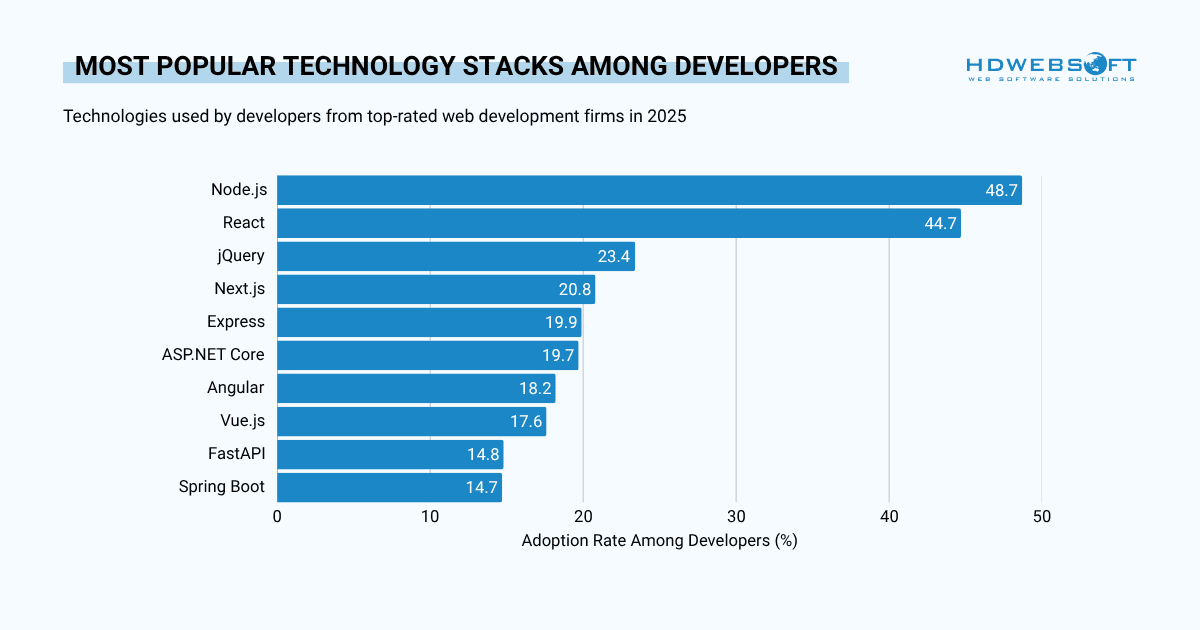
Red Flags and Common Mistakes to Avoid
When evaluating seemingly reputable providers for website development solutions, certain warning signs should prompt careful reconsideration or additional due diligence.
Choosing Based on Price Alone
The cheapest proposal almost certainly cuts critical corners. Development costs reflect team expertise, process maturity, and quality standards. They are the areas where shortcuts create long-term problems.
Exceptionally low bids often indicate offshore subcontracting without disclosure, junior developers who’ll require extensive oversight, or missing scope items that will surface as expensive change orders. Any proposal more than 40% below market averages deserves scrutiny.
Instead, evaluate the proposals of top-rated web development firms based on the value delivered versus the cost incurred. A $150,000 project that launches on time with clean code provides better value than a $75,000 project requiring another $100,000 to fix quality issues.
Ignoring Portfolio Quality
Impressive-looking websites in portfolios may mask concerning realities about actual involvement or technical quality. Some companies showcase designs they created but didn’t develop.
Dig deeper by asking about specific contributions to featured work, requesting to see live sites (not just screenshots), and checking whether portfolio projects match your complexity level. A company showcasing primarily simple WordPress sites may struggle building complex custom applications.
Skipping the Contract Review
Development contracts protect both parties, yet many clients sign without careful review or legal consultation.
Critical elements in a contract start with scope documentation and acceptance criteria. Then come payment terms and schedules. Intellectual property ownership provisions also play a central role. After that, the change order processes should be set. Termination clauses provide legal clarity. Finally, warranty and support terms add protection.
When selecting from top-rated web development firms, ensure that contracts exceeding $25,000 include a legal review to prevent more expensive problems later.
Poor Communication During Vetting
How companies communicate before signing contracts predicts how they’ll communicate during development. Red flags include delayed responses to inquiries, vague answers to avoid direct questions, and difficulty scheduling meetings or calls.
Quality companies demonstrate respect for your time. They’ll provide thoughtful responses addressing your specific concerns and maintain consistent communication throughout the evaluation process.
Unrealistic Promises or Timelines
Experienced developers recognize that estimates involve uncertainty, and complexity often exceeds initial assumptions. You should be skeptical of companies that guarantee specific search rankings. Likewise, promises of zero bugs are unrealistic.
Furthermore, beware of claims that projects can be built in half the time competitors quoted. And above all, be wary if a company suggests complex projects can be finished in mere weeks instead of months.
Lack of Post-Launch Support
Website and application development don’t end at launch. In fact, ongoing maintenance, security updates, and enhancement support prove essential for long-term success.
Quality top-rated web development firms offer maintenance packages, proactive security monitoring, performance optimization services, and capacity for future enhancement work. Hence, you should discuss post-launch support during initial conversations.
Not Checking Technical Expertise Thoroughly
Marketing materials may claim expertise in every technology and framework, yet real proficiency requires years of focused experience.
Verify technical capabilities by requesting code samples, asking detailed questions about their recommended approach, and discussing specific frameworks in depth. If technical discussions feel superficial, their claimed expertise may be overstated.
When your project requires front-end web development with modern frameworks, check that the team understands and can demonstrate current knowledge. Technologies evolve every day; knowledge that was solid five years ago may no longer be applicable today.
Conclusion
Choosing from among the top-rated web development firms is a critical decision that will shape your digital presence for years to come. The most successful partnerships emerge when you define your requirements clearly, research potential partners thoroughly, and verify their capabilities through references and case studies. Remember to take the time to evaluate companies systematically. That way, you’ll find a development partner who delivers web development solutions that scale alongside your business growth.









